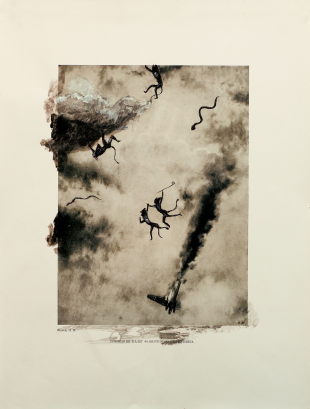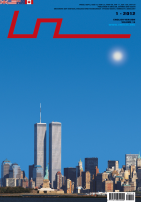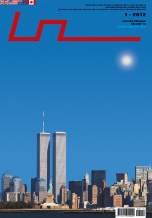| Revista Umělec 2012/1 >> African Vampires in the Age of Globalisation | Lista de todas las ediciones | ||||||||||||
|
|||||||||||||
African Vampires in the Age of GlobalisationRevista Umělec 2012/114.11.2012 16:33 David McNally | solutions | en cs de |
|||||||||||||
|
"In Cameroon, rumours abound of zombie-labourers toiling on invisible plantations in an obscure night-time economy."
From various parts of Sub-Saharan Africa today come unsettling tales of vampires and zombies and of extraordinary intercourse between the living and the dead. A whole slew of folktales, spanning oral culture, videos and pulp-fiction, depicts processes of magical accumulation that traverse the world of the occult. In Nigeria, newspapers carry reports of passengers on motorcycle-taxis, who, once helmets are placed on their heads, transform into zombies and begin to spew money from their mouths, as if they had become human ATMs. In Cameroon, rumours abound of zombie-labourers toiling on invisible plantations in an obscure night-time economy. Similar stories of possessed workforces emanate from South Africa and Tanzania, including tales of part-time zombies, captured during their sleeping hours, only to wake up exhausted after their nocturnal exploitation. While labour is seen as possessed, money too is said to be enchanted. Congolese stories, for instance, tell of ‘bitter’ dollars, secreted within their possessors’ homes, whose sudden and uncontrolled growth crushes their entrapped owner. Commodities too partake in these bizarre powers of expansion; tales flourish in southwestern Congo, for instance, of people being possessed and devoured by diamonds. Similar accounts of extraordinary transactions between money and human bodies thrive in film and video. In Ghana, a popular 1990s video-film called Diablo depicts a man who transforms himself into a python, enters a prostitute’s vagina and, after metamorphosing back into human form, collects the banknotes she vomits forth – thereby harnessing female reproductive powers for purposes of economic accumulation. More recently, a widely popular Nigerian video-film, Living in Bondage (1992–3) – which launched ‘Nollywood,’ today the world’s third largest film-industry – portrayed a man who acquires riches after sacrificing his wife and drinking her blood. Literally hundreds of video-films have followed its path, expanding the immensely popular genre of ‘voodoohorror.’ All of these examples merely scratch the surface of a rich and expansive popular genre. As much as Nigerian mass-culture is a focal point for the dissemination of these images, such folktales emanate, with unique local inflections, from one part of the African subcontinent to another, telling of credit-cards that provide instant commodities without registering debt, of magical coins that turn people into zombies, and of enchanted currencies that leave cash-registers and return to their owners after every purchase. Most striking perhaps is the epidemic of stories of dismemberment and murder for the harvesting of body parts that bring riches, either as commodities for sale or as ingredients in magic-potions. In Tanzania, for instance, legends proliferate concerning the murder of children whose skins are sold (at prices of around $5,000) for occult purposes. And among miners involved in the illicit diamond-trade between Angola and Congo, workers maintain that, when digging is unsuccessful, it is necessary to sacrifice either male sperm or a body-part – a finger or an eye – in order to lift a curse that restricts productivity. Not surprisingly, blood figures prominently in a whole slew of vampire-type stories. In Malawi in late 2002 and early 2003, for instance, government-leaders were widely denounced, and occasionally attacked, for their alleged participation in a blood-theft ring that was purported to trade blood to international agencies in exchange for food-aid. While Malawi’s president repudiated these accusations, proclaiming that ‘No government can go about sucking the blood of its own people – that’s thuggery,’ such protestations find little traction with people who have seen infant mortality-rates soar and life expectancies plummet in an era of globalising capital. These Malawian tales are instructive for the ways they situate human bodies in the vampire-like circuits of international capital. This too is a recurrent feature of recent witchcraft-legends. In Cameroon, for example, a host of stories depict local mafias that export zombified labourers to Europe. In another set of narratives from Malawi, youths describe aeroplanes, the essential means of transportation in the age of globalisation, which are built from human bones and fuelled by human blood. Similar occult dialectics of the local and the global are enacted in Ghana, where a young Akan priest promotes his anti-witchcraft shrine by claiming to ‘understand market wars’ – the better to offer lucrative ‘international opportunities’ – while another pronounces that ‘the god who possesses me . . . has travelled to London and Frankfurt . . . he can decide the cocoa price if he wishes.’ As we have seen, perhaps nowhere are legends of enrichment through disembodiment more widespread and compelling than in Nigeria. Popular Yoruba theatre, for instance, rehearses stories of child-stealers who, after abducting their young prey, trap them in secret rooms and use their blood to make medicines which, in combination with the correct utterances, cause money to pour into a calabash set upon the children’s heads. In Akinbolu Babirinsa’s novel, Anything for Money, a Fulani herdsman in northern Nigeria discovers a metal-box containing a human head used for purposes of ‘money magic.’ Employed properly, it churns out wads of crisp twenty naira banknotes. But it is in the video-industry that such tales have proliferated most promiscuously. Churning out up to 1500 films annually, Nollywood’s most popular genre is ‘juju’ or voodoo-horror, ‘supernatural thrillers involving spirits, vampires and ghosts,’ meant to ‘provide emotionally-satisfying explanations for wealth inequalities of injustices that abound in Nigeria.’ Like all fables of modernity, these legends are more than the stuff of oral culture, literature, video and film. The fears, anxieties and values they express permeate everyday life, defining and shaping social perceptions and political action as much as the domains of folklore, literature and film. One example may be enough to illustrate this point, that of the ‘Otokoto Riots’ of 1996 in the Nigerian city of Owerri, when rumours of witchcraft sparked a local uprising. The prelude to the riots was the disappearance on 19 September of that year of a young boy, Anthony Ikechukwu Okonkwo, one of a number of the city’s children who had disappeared or been abducted since 1994. Three days later, an employee of the Owerri Otokoto Hotel, Innocent Ekeanyanwu, was apprehended transporting the missing boy’s head, wrapped in plastic in the trunk of a rented car. TV-stations widely broadcast clips of the accused abductor holding the boy’s head. Within hours of the first reports, hundreds of men gathered in the city’s central market and proceeded to attack houses and cars of Owerri’s nouveaux riches, along with three buildings that housed two ‘new breed’ evangelical churches and one ashram. On 23 September, the day after his apprehension, Innocent Ekeanyanwu died in police-custody, arousing suspicions he had been murdered to protect his wealthy employers. The next day, police dug up the headless body of the murdered child in the compound of the Otokoto Hotel. A crowd again gathered and commenced to burn the hotel, a nearby department-store that catered to the rich, and a number of select stores, hotels and businesses connected with ‘419 men,’ wealthy speculators whose riches are associated with fraud and corruption. On 25 September, rioting and burning resumed, sparked by the alleged discovery of a roasted human corpse at the residence of one of Owerri’s young millionaires, and of human skulls and ‘human pepper-pot soup’ purportedly found in the Overcomers’ Christian Mission, a pentecostal church where the rich man worshipped. The rioters also targeted suspected traffickers in human body-parts, including Vincent Duru, owner of the Otokoto Hotel, who was alleged to have kept a huge cache of body-parts in a freezer in his village-home. By the time the riots ended, more than twenty-five buildings and dozens of vehicles had gone up in flames. Several features of these events are especially noteworthy. Not only did the riots target 419 men, the embodiments of illegitimate wealth; they also appear to have been hugely popular. Equally significant, the eleven year-old victim came from a poor family and had been out hawking boiled peanuts for his guardians the day he went missing. The passions incited by his abduction and murder clearly resonated with anxieties about the market as a space that endangers bodily integrity, particularly for the young. Perhaps most instructive is the specific set of exaggerations that animated public accounts of the criminal investigation:
That the exaggerations should focus on corpses and detached body-parts is, I submit, anything but accidental. Moreover, if we care for the truth-value of exaggerations, to paraphrase Adorno, then we ought to attend to their deep significance as markers of capitalist modernity, as clues to the texture of everyday-life in Nigeria in the age of globalisation. We might approach this deep meaning via an apparently unrelated newspaper-article, published almost a year and a half after the Otokoto Riots, in which an editorialist with the Post Express Wired writes of Nigeria’s largest city:
Note here the way in which a human corpse becomes a modern ‘moneymachine’ and in which ritual-killings and disappearances are means of enrichment for the perpetrators. It is as if capital-accumulation in Lagos, a ‘dumping ground for corpses,’ traverses a cadaverous economy. While it is true that sorcery is not explicitly invoked in this editorial, the passage bears all the marks of the current genre of tales of bewitched accumulation. As one commentator on the Otokoto events observes, ‘stories of child kidnappings, ritual killings, trade in body-parts, and other magical practices form part of a dynamic cultural complex for which witchcraft serves as a crude but widely recognized label.’ The author continues by reading tales of kidnapping and murder as phenomena that symbolically ‘stand for the violence and polarization that increasingly undergird the structure of inequality in contemporary Nigeria.’ Yet, this is to radically under-theorise these events. To be sure, these are stories about the violence of inequality and social polarisation. But they are stories organised according to specific tropes, which pivot on images of dissection, corporeal fragmentation and disembodiment. And the specificities of such imagery require explanation. Consider, as cases in point, the claims for a pepper-pot soup full of human body-parts that is central to the Otokoto events, or the rumour that 200 human male organs were found in a goat’s belly at Vincent Duru’s village-house. If the popular imagination simply seeks fantastic depictions of inequality, it is not clear why it should turn so persistently to images of dissection, to the chopping up of human bodies. It is precisely this – the persistence of images of corporeal fragmentation and disembodiment – that I seek to scrutinise. There is no doubt that all such imaginings are multivalent, weaving together diverse strands of human experience – histories of race, gender, class, and kinship; memories of slavery, colonialism and war; experiences of marketised and monetised social relations; the savage consequences of structural adjustment-programmes; the corruption of postcolonial élites; the devastation wreaked by an AIDS-pandemic – into coherent local discourses. There is also little doubt that these images have a multitude of local determinations that frequently elude even the most sensitive ethnographer. But, pulsating through the multifarious local moments of these aesthetics of horror, we find recurring images of accumulation via corporeal dismemberment and possession. And it is this strand – these powerful depictions of enrichment through disembodiment – that I wish to explore as explanatory markers of life in late capitalism. I make no claim for the comprehensiveness of this account. It is inherent in the phenomena under investigation that they overflow with localised meanings. But, unless we are content to adopt a cult of the local, unless we are prepared to ignore the general social phenomena at work at the micro-level, then it is imperative that we take up ‘the challenge of linking small acts to wider processes,’ as one analyst of agrarian change and class-formation in Africa has put it. Of course, to dialectically locate the global within the local involves recognising that the ‘macro’ itself exists only in and through the concrete particulars that compose it. But the reverse is true as well; the particular exists only in and through its interrelations with other particular moments and experiences. Together, these constitute a concrete totality, a rich complex of ‘many determinations and relations,’ ‘the unity of the diverse.’ The concepts ‘local’ and ‘global’ do not refer, therefore, to actually existing entities or domains of life which the critic must then connect to one another. Even when analytically isolated by the critic, they are always lived together in their dialectical unity. What these terms capture are aspects or moments of the rich, complex, diverse and many-sided phenomena that constitute everyday life in the age of globalising capitalism. But, because a concrete totality is always internally differentiated, a ‘unity of the diverse,’ we can tease out that diversity by attending to regional spaces within the world-system and the regional imaginaries which there arise. (...) One of the reasons that local grammars and vocabularies are so powerfully resonant is that capital, contrary to a too-simple picture, does not extinguish the local, however much it works to impose its social logic on pre-existing forms of social life. Despite its absolutising pretensions, global capitalism operates by systematically re-organising existing social formations – disarticulating and rearticulating property, labour, authority, gender, sexual norms, family and community – so as to facilitate the accumulation of capital. Rather than literally invent a world in its image, capitalism exhibits a unique dialectic of incorporation, in which it accommodates the particular at the very moment it absorbs and refashions it. As a result, local cultural idioms are replete with knowledge of the global. Narrating experiences of incorporation into the circuits of capitalism, local idioms subtend the cacophonous language of capitalist modernity. Rather than expressing ‘traditional’ values and meanings outside of modernity, these idioms capture the concrete enactment of the global at the level of lived experience, as well as the counter-narratives that probe the prospects for other histories, for social projects outside the logics of global capital. To be sure, all such regional imaginaries are formed through the differences – of class, gender, sexuality, ethnicity and more – that comprise the dialectic of the local and the global. As a result, circuiting across and between these locations is a network of contested meanings. And the matrix of flows and counter-flows of meanings includes narratives from the ‘peripheries,’ as well as the centres of economic and cultural accumulation. From the start, modernity has been crucially formed in and through the cultural experiences of Africa and the African diaspora. It follows that capitalist modernity is a world-process, not a merely regional one, however much it unfolds through global hierarchies and subordinations. Indeed, as we shall see shortly, one of the central images of the monstrosity of the market – the zombie – is a product of the African experience that was reworked first in Haiti, then discovered and adapted by Hollywood, only to be transformed again in recent African folktales. In the figure of the zombie-labourer, a key marker of modernity, we find traces of global circuits of capital and its others, and of the ways in which the latter imagined a new world of experience. Zombie-tales, like contemporary witchcraft-stories in Sub-Saharan Africa, are thus fables of modernity. To treat them as such, however, is to challenge the notion that, since modernity ‘disenchants’ the world by ridding it of spirits, witchcraft-tales can only be expressions of ‘traditional’ or ‘premodern’ values and beliefs in opposition to the norms of modernity. Not only does such a view reproduce the colonialist illusion that Africans are prehistorical, peoples outside of history – precisely the racialised image mobilised by Hegel, which I shall discuss below; it also ignores the extent to which the emergence of modernist notions of space and time had to do intimately with the colonial relation, with the attempt to relate different spatio-temporal orders, such as those encountered in Africa, to that of Europe. Africa and Africans were present at the birth of modernity, however much they are differentially implicated in it. More than this, notions of Africa as a premodern space also serve a deeply apologetic and ideological function, placing the enduring production of global poverty and social exclusion, of global apartheid, outside the dynamics of world-capitalism. (...) Rather than expressions of traditional values in opposition to the forces of capitalist modernity, recent urban discourses of bewitchment in Sub-Saharan Africa comprise complex, multilayered readings of the changing circumstances of social life in the age of globalising capitalism. Certainly, older idioms and orders of meaning are drawn upon in the elaboration of modern cultural semantics. But this is merely to note that meanings are always historical, that they do not conform to formalist principles of structural typology but, instead, involve never-ending re-workings of earlier modes of social thought and perception accompanied by the incorporation of new idioms of thought and feeling. New ways of imagining thus emerge out of hybrid configurations of old and new, indigenous and ‘foreign’ systems of meaning. To take a single example, there seems little doubt that new rituals and structures of belief regarding witchcraft ‘accompanied the incorporation of rural African communities into colonial capitalist labour markets.’ While employing older idioms, novel and urgent problems of social life demanded new discursive forms, new grammars of experience. My concern here is with a recent genre of urban African witchcrafttales – one that speaks to the occult economies of globalising capitalism. These stories emerge according to unique patterns during the last quarter of the twentieth century, the classic era of ‘globalisation,’ and persist into the new one, as a principally urban genre. They take root in a soil in which older kinship-patterns and forms of rural economy have been significantly eroded; they flourish in the increasingly anonymous and commodified spaces of large cities. While they are preceded by other semantic shifts in the folklore of witchcraft, particularly alterations that occur in the period between the World-Wars, there is something highly distinctive about the way these tales articulate troubling relations involving money, global markets, zombielabour and human body-parts. At its heart, this genre of witchcraft-stories seeks to apprehend and evaluate the social practices and social ontology of capitalism – the acquisitive, accumulative, individualist modes of behaviour and the unique processes of abstraction and disembodiment characteristic of an economy organised by value-relations and money. At the same time, it also registers semantic shifts that highlight the intensification of commodified relations and the growing financialisation of contemporary capitalism.
Text was selected from the writer‘s book *Monsters of Market: Zombies, Vampires, and Global Capitalism*, Leiden: BRILL, 2011.
14.11.2012 16:33
Artículos recomendados
|
|||||||||||||
|
04.02.2020 10:17
Letošní 50. ročník Art Basel přilákal celkem 93 000 návštěvníků a sběratelů z 80 zemí světa. 290 prémiových galerií představilo umělecká díla od počátku 20. století až po současnost. Hlavní sektor přehlídky, tradičně v prvním patře výstavního prostoru, představil 232 předních galerií z celého světa nabízející umění nejvyšší kvality. Veletrh ukázal vzestupný trend prodeje prostřednictvím galerií jak soukromým sbírkám, tak i institucím. Kromě hlavního veletrhu stály za návštěvu i ty přidružené: Volta, Liste a Photo Basel, k tomu doprovodné programy a výstavy v místních institucích, které kvalitou daleko přesahují hranice města tj. Kunsthalle Basel, Kunstmuseum, Tinguely muzeum nebo Fondation Beyeler.
|

































 New book by I.M.Jirous in English at our online bookshop.
New book by I.M.Jirous in English at our online bookshop.
Comentarios
Actualmente no hay comentariosAgregar nuevo comentario